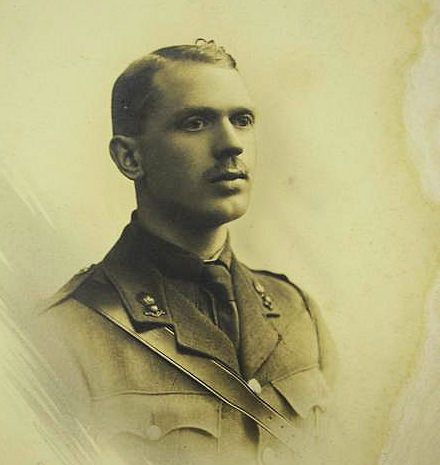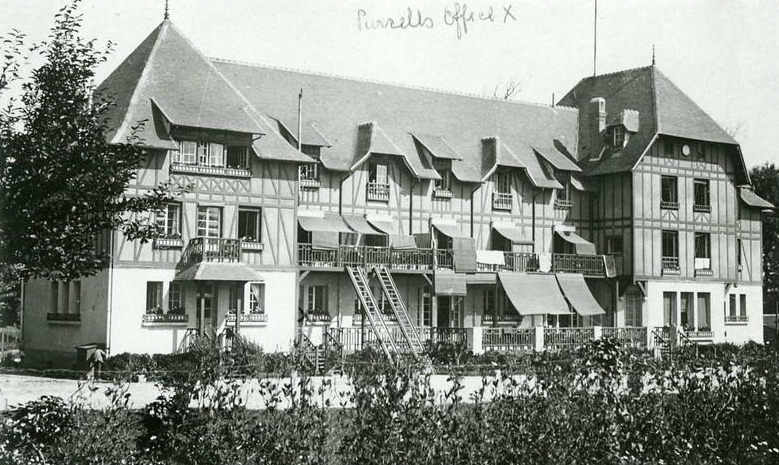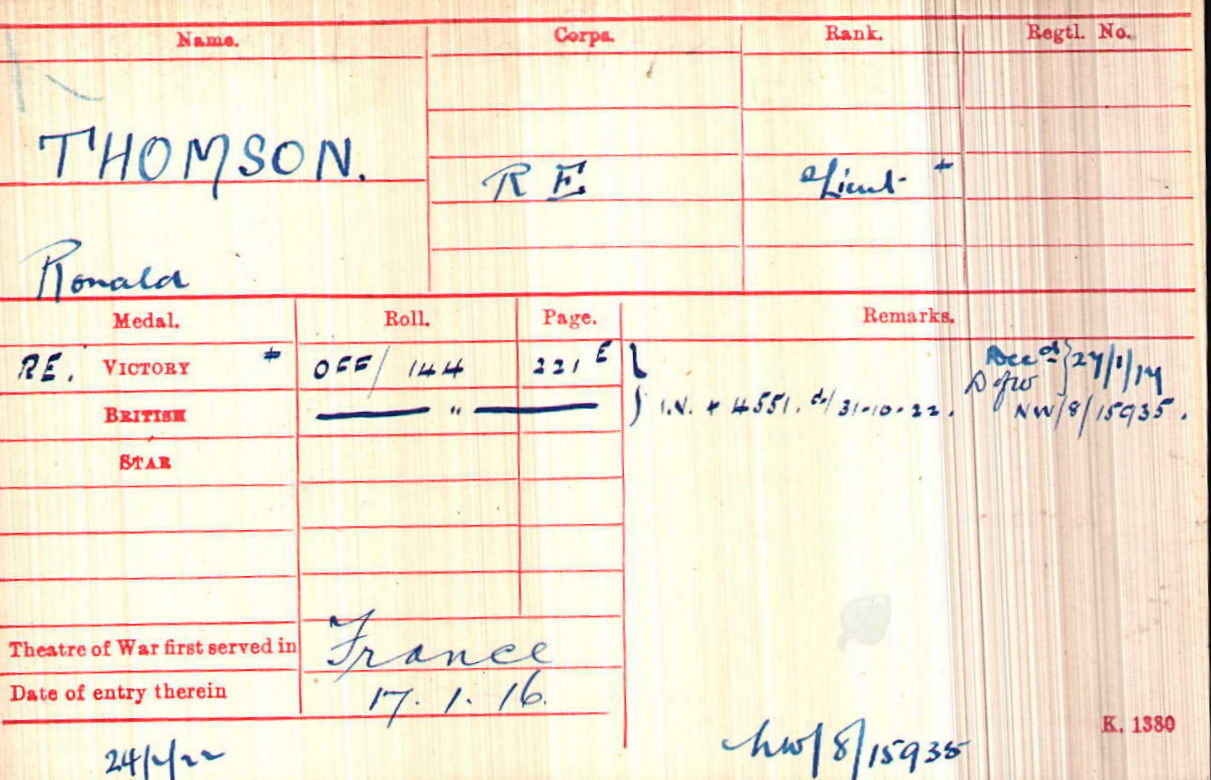
Figure 1. 2nd Lieutenant Ronald Thomson, R.E.
(Image courtesy of the Imperial War Museum)
2nd
Lieutenant
RONALD
THOMSON
Royal Engineers
by
Lieutenant Colonel (Retired) Edward De Santis,
MSCE, P.E., MinstRE
(August 2023)

Figure 1. 2nd Lieutenant Ronald
Thomson, R.E.
(Image courtesy of the Imperial War Museum)
1. INTRODUCTION
As was the case with so many other officers of the Royal Engineers, this man died of wounds received from an indirect fire weapon. Enemy artillery fire seems to be the cause of most deaths of R.E. officers and men during the trench warfare phase of the Great War of 1914-1918. The nature of the work done by the Sappers during the war was such that they rarely met the enemy eye-to-eye, but they still had to fear light, medium and heavy artillery fire on their positions as well as trench mortar fire that ultimately took the life of Lieutenant Thomson.[1]
Family Information
Ronald Thomson was born in Rotherham, Yorkshire on 18 October 1886. He was the son of Andrew Thomson (1849-1915) and Emily Louise Thomson, née Frith (1858-1938). Andrew Thomson was originally from Limekilns, Fife in Scotland. Emily Louise Frith was born in Ballina, Sligo, Ireland. The Thomsons had three daughters: Anita Thomson (1882-1959), Emily May Thomson (1889-1933) and Helen Edna Thomson (1893-1951). All of the Thomson girls were also born in Rotherham.[2] In addition to Ronald, the Thomsons had another son; Andrew Thomson (1884-1963), also born in Rotherham.
Early Life
Young Ronald was educated at Willaston School in Nantwich, Cheshire where he was a boarding pupil.
In 1911 he was employed as a colliery deputy. This position can be compared to a supervisor who was responsible for an area of the pit underground. He would walk the roadways (tunnels) and crawl along the coal face where men were working. He would have supervised all aspects of health and safety and mostly stop and speak to the men in his area or district. There would be a deputy on that district/area every shift and they would "hand over" to each other as their shifts ended.
In 1912 Ronald Thomson was working as a Mining Engineer for the Rothervale Coal Company. No evidence has been found to indicate that he had any formal education as a Mining Engineer, so it is likely that he was filling a position that made him responsible for the performance of a number of colliery deputies.
By 1915 Thomson had changed occupations completely and was working as a Brass Founder for W.N. Baines and Company in Rotherham. A Brass Founder was an individual who casts objects from brass. W.N. Baines and Company were contractors to the British Admiralty and it is likely that Thomson’s work involved casting bells and ship fittings. There does not appear to be any relationship between this work and working in a coal mine. It may just be that he became disenchanted with working underground. If so, he would soon begin to work underground again when he joined the Army.
3. COMMISSIONING AND TRAINING
Commissioning
On or about 20 December 1915 Ronald Thomson made application for a commission in the Corps of Royal Engineers. With so much supervisory experience he had as a Colliery Deputy and as a Mining Engineer, the Corps looked favorably on his application, especially as it met the needs for the tunnelling companies that where being formed. The 185th Tunnelling Company had just been formed in Rouen in October 1915 and had been moved immediately to the Somme area for work at La Boisselle. This company needed officers with experience with tunnelling work, therefore on 5 January 1916 Ronald Thomson was granted a commission as a Temporary 2nd Lieutenant in the Royal Engineers.[3]
Training
With his experience working in coal mines, Thomson was considered to have the technical qualification needed for tunnelling work. After a brief period of military training, probably at the School of Military Engineering (S.M.E.) at Chatham, Kent, he was considered to be ready to serve with a tunnelling company on the Western Front, specifically the 185th Tunnelling Company.
4. POSTINGS AND CAMPAIGN SERVICE
Temporary 2nd Lieutenant Ronald Thomson arrived in France on 17 January 1916.[4] He joined the 185th Tunnelling Company at Albert in February and was greeted by a group of officers whose morale was at a low point. Major Thomas Charles Richardson, M.C., R.E., Officer Commanding the 185th, had just been killed on 4 February when the Germans had exploded two “Camouflets,”[5] which destroyed some galleries of the company’s mine system. Lieutenant A.J. Latham, R.E. and a number of men also were killed, chiefly from gassing.[6]
In mid-March 1916 Major E. Tulloch, D.S.O., M.C., R.E. took command of the company and the unit moved to the "Labyrinth" sector near Vimy. The German "Labyrinth" stronghold was located near Neuville-Saint-Vaast, between Arras and Vimy and not far from Notre Dame de Lorette. The 185th Tunnelling Company shared this sector with the 176th Tunnelling Company, which had moved to Neuville-Saint-Vaast in April 1916 and remained there for a considerable time, and the 172nd Tunnelling Company, which was relieved in this area by the 2nd Australian Tunnelling Company in May 1916.[7]
The front sectors at Vimy and Arras, where extremely heavy fighting between the French and the Germans had taken place during 1915, had been taken over by the British in March 1916. Vimy, in particular, was an area of busy underground activity. British tunnellers progressively took over military mining in the area from the French between February and May 1916. Other units active around Vimy were the 175th , 182nd , 184th and 255th Tunnelling Companies. From the spring of 1916, the British had deployed five tunnelling companies along the Vimy Ridge, and during the first two months of their tenure in the area, 70 mines were fired, mostly by the Germans. Between October 1915 and April 1917 an estimated 150 French, British and German charges were fired in this 4.3-mile sector of the Western Front.[8]
On 29 March 1916, the 185th Tunnelling Company was relieved at Roclincourt-Chantecler by the New Zealand Tunnelling Company. On 31 March the 185th was at Ariane Dump and La Sablière under GHQ control. During the summer and much of the autumn of 1916, the unit further developed and expanded its mining to create an effective underground defence at Roclincourt-Chantecler. In May 1916, a German infantry attack at Vimy, which forced the British back about 700 yards, was aimed at neutralizing British mining activity by capturing the shaft entrances. From June 1916, however, the Germans withdrew many miners to work on the Hindenburg Line and also for work in coal mines in Germany. In July the 185th Tunnelling Company was back at Albert.[9]
In the second half of 1916 the British constructed strong defensive underground positions, and from August 1916, the Royal Engineers developed a mining scheme to support a large-scale infantry attack on the Vimy Ridge proposed for autumn 1916, although this was subsequently postponed. After September 1916, when the Royal Engineers had completed their network of defensive galleries along most of the front line, offensive mining largely ceased although activities continued until 1917. The British gallery network beneath Vimy Ridge eventually grew to a length of about 7½ miles.[10]
The Canadian Corps was posted to the northern part of Vimy Ridge in October 1916 and preparations for an attack were revived for February 1917. In October half of the 185th Tunnelling Company was in the First Army sector and half in the Third Army sector. In November the company was ordered to extend its front on the left, thereby taking over the mine systems of the 175th Tunnelling Company. This made the 185th responsible for a length of front extending from Roclincourt to Neuville St. Vaast. The company’s front line dugouts were changed with No.1 and No. 2 Sections taking over the company’s old Vase dugouts in the Vase Avenue, while No. 3 and No. 4 Sections went into Zivy dugout at the junction of Zivy Avenue and Doublement front line. The dugout question soon became acute. Situated at the extreme flank of the company area, in case of urgency it was impossible to get to the danger point quickly and the state of the trenches was so bad with mud thigh-deep and sticky, that one could not avoid a trench-mortar attack. Lieutenant J.B. Joseph, R.E. was caught in this way and blown to pieces on 8 January 1917. He had been with the company for about nine months and was a popular officer. Then on 21 January 2nd Lieutenant Ronald Thomson was fatally wounded just outside the entrance to the ill-sited new dugout at Haute Avesnes by a trench mortar bomb. Thomson was taken to No. 10 British Red Cross Hospital at Le Treport where he died on 27 January 1917.[11]

Figure 2. No. 10 British Red Cross Hospital.
(Image
courtesy of the British Red Cross Museum and Archives)
2nd Lieutenant Ronald Thomson was buried in the Le Treport Military Cemetery, Plot 2, Row O, Grave 4. His headstone shows him as a 2nd Lieutenant; however the London Gazette of 17 May 1917 shows that he was promoted to Lieutenant on 15 February 1917, 20 days after his death. Then the London Gazette of 19 May rescinded his promotion when it finally came to the attention of the War Office that Thomson had died of his wounds before the effective date of his promotion.
Probate of Thomson’s Will took place in London on 15 June 1917. His effects in the amount of £3365, 15 shillings and 7 pence (about $274,460 US in 2023 currency) were left to his brother, Andrew Thomson, Brass Founder.[12] Apparently Thomson had earned and saved a considerable amount working as a Mining Engineer and Brass Founder before his entry into the Army.
MEDALS, AWARDS AND DECORATIONS
For his service during the Great War 2nd Lieutenant Ronald Thomson was awarded the British War Medal and Victory Medal. His Medal Index Card indicates that the medals were presented to his mother on or about 22 February 1922. She was a widow living at Melton House on Gerard Road in Rotherham, Yorkshire. In addition to these medals she would have received a bronze Memorial Plaque to commemorate his death during the war.
|
Figure 4. The Memorial Plaque. |
NOTE: The medals and the plaque are not those of 2nd Lieutenant Thomson. They are shown here for illustrative purposes only.

Figure 5. The Medal Index Card of 2nd
Lieutenant Ronald Thomson, R.E.
(Image courtesy of
Ancestry.com)
ANNEX A
List of Officers Who Served in the 185th Tunnelling Company, 1915-1919
Captain T.C. Richardson, M.C., Officer Commanding, 1915-1916 (Killed in action, 4 February 1916).
Major E. Tulloch, D.S.O., M.C, Officer Commanding, 1916-1919.
__________________________________________________________________________
Captain D. Bowen
Lieutenant L.E. Cutts (Died on Service)
Lieutenant H. Casson
Captain R.H. Cardwell, M.C. (A section commander)
Lieutenant R.D.T. Davies
Lieutenant Cyril Nutcombe Davies (Died 1 March 1919)
Lieutenant C.G.N. Dunere
Lieutenant W. Davison
Lieutenant R.D. Douglas (Died after the war)
Lieutenant H.M. Eddowes, D.S.O.
Lieutenant W.E. Figgis
Lieutenant S. Forrest
Captain H.W. Graham, M.C.
Lieutenant J.S. Garment
Captain H.C. Hall (A section commander)
Lieutenant E.R. Howland
Lieutenant S. Hill
Captain G. Howatson, D.S.O.
Lieutenant J.B. Joseph (Killed in action, 8 January 1917)
Lieutenant A.B. Knox (Killed in action, 15 December 1915)
Captain Alfred Emerson Lance
Captain E. Lyall, D.S.O. (A section commander)
Lieutenant A.J. Latham (Killed in action, 4 February 1916)
Lieutenant J.D. Latham
Lieutenant C.W. Masterson
Lieutenant P.H. McDouall
Lieutenant F. Nicholls
Lieutenant M.L. Parrington
Captain B.D. Plummer, M.C.
Lieutenant J.W.H. Ross, M.C.
Lieutenant B. Rount
Lieutenant H. Rickard
Lieutenant H.O. Routledge
Captain D.A.Mc.M. Spence (Company Adjutant)
Lieutenant C.G.B. Smith
Lieutenant C.J. Scoffield
Lieutenant Percy B. Shute
Captain T.H. Smith
Captain W.F. Tomlinson (A section commander)
Lieutenant A. Tait
Lieutenant Ronald Thomson (Died of wounds, 27 January 1917)
Lieutenant W.E. Wilson, D.S.O., M.C.
Lieutenant E.W. Waterfield
Lieutenant J. Wilson
Lieutenant J.S. Young, M.C.
Source: GRAHAM, H.W. Life of a Tunnelling Company. J. Catherall & Co., Hexham, 1927.
ANNEX B
Casualties of the 185th Tunnelling Company, 1915-1918 |
|||||||
Date of |
Regtl. |
||||||
Name |
Forename |
Initials |
Death |
Rank |
Number |
||
REYNOLDS |
A C |
14/03/1916 |
Sapper |
89271 |
|||
THOMSON |
RONALD |
R |
27/01/1917 |
2nd Lieut. |
|||
PHIPPS |
LAURENCE UGHART EDWARD |
L U E |
9/11/1918 |
Sapper |
540531 |
||
ALLAN |
ALEXANDER |
A |
25/03/1918 |
Sapper |
148639 |
||
LANE |
P |
4/2/1916 |
Sapper |
102439 |
|||
REDFERN |
ALFRED |
A |
30/01/1917 |
Sapper |
132623 |
||
KNOX |
ANDREW RONALD |
A R |
12/12/1915 |
2nd Lieut. |
|||
RYDER |
WILFRED |
W |
13/04/1916 |
Sapper |
79105 |
||
COX |
J |
10/4/1917 |
Sapper |
112963 |
|||
GIBSON |
J |
4/2/1916 |
Sapper |
107811 |
|||
BICKNELL |
J T |
4/2/1916 |
Sapper |
121597 |
|||
MARSHALL |
A |
4/2/1916 |
Sapper |
94492 |
|||
FOWKES |
L |
4/2/1916 |
Sapper |
139189 |
|||
HEWITT |
J |
4/2/1916 |
Sapper |
86455 |
|||
LUMSDAINE |
L |
4/2/1916 |
Sapper |
86574 |
|||
MURPHY |
WILLIAM |
W |
4/2/1916 |
Sapper |
91972 |
||
PARRY |
HENRY |
H |
4/2/1916 |
Sapper |
102029 |
||
PRITCHARD |
W |
4/2/1916 |
Sapper |
96939 |
|||
SWITHENBANK |
J W |
4/2/1916 |
Sapper |
132651 |
|||
THOMPSON |
A |
4/2/1916 |
Sapper |
139187 |
|||
HEALD |
W |
4/2/1916 |
Sapper |
121523 |
|||
NELSON |
A |
4/2/1916 |
Sapper |
132396 |
|||
WASHINGTON |
J |
4/2/1916 |
Lance Corp. |
79122 |
|||
SIMPSON |
F L |
4/2/1916 |
Sapper |
112866 |
|||
HARRIS |
CLIFFORD AUGUSTUS |
C A |
23/12/1915 |
Sapper |
36987 |
||
ROWLEY |
W |
16/07/1917 |
Corporal |
132535 |
|||
ROBINSON |
JOHN WILLIAM |
J W |
14/07/1916 |
Serjeant |
82691 |
||
RANDALL |
J W |
18/11/1916 |
Sapper |
121775 |
|||
ROBERTSON |
ALEXANDER |
A |
25/08/1918 |
Sapper |
183100 |
||
SISSONS |
FRANK |
F |
23/12/1915 |
Sapper |
112976 |
||
DAWSON |
W |
15/06/1918 |
Corporal |
156170 |
|||
EGAN |
R |
15/06/1918 |
2nd Corporal |
91967 |
|||
WISEMAN |
A |
12/4/1916 |
Serjeant |
139008 |
|||
BATTY |
J |
16/08/1918 |
Serjeant |
79793 |
|||
Source: The Commonwealth War Graves Commission.
REFERENCES:
Books
GRAHAM, H.W. Life of a Tunnelling Company. J. Catherall & Co., Hexham, 1927.
GRIEVE, H.W. & NEWMAN, R. Tunnellers. Herbert Jenkins Limited, London, 1936.
Civil Documents
1917 Probate Calendar, p. 65.
Family Trees
Second Lieutenant Ronald R.[sic] Thomson (1886-1917) (by Joanne Snyder).
Andrew Thomson (1849-1915) (by dhowse235)
Internet Web Sites
Great War Forum. https://www.greatwarforum.org/topic/224743-rotherham-grammar-school-great-war-memorial/
Imperial War Museum: Lives of the First World War. https://livesofthefirstworldwar.iwm.org.uk/searchlives/field/unit/Royal%20Engineers/filter
3. Wikipedia: 185th Tunnelling Company. https://en.wikipedia.org/wiki/185th_Tunnelling_Company
4. British Genealogy. https://www.british-genealogy.com/forum/threads/17593-Colliery-Deputy-(Below-Ground)
5. Commonwealth War Graves Commission. https://www.cwgc.org
6. British Red Cross. https://museumandarchives.redcross.org.uk/objects/14970
London Gazette
Supplement to the London Gazette, 19 May 1917, pp. 4885 and 4886.
Supplement to the London Gazette, 6 June 1917, p. 5598.
Military Documents
Commonwealth War Graves Commission Memorial. www.cwgc.com
Periodicals
Battle Honours of the Royal Engineers. The Royal Engineers Journal. The Institution of Royal Engineers, Chatham, Kent, 1925-1932.
ENDNOTES:
[1] Although I have listed Thomson as a 2nd Lieutenant, he actually was promoted to the rank of Lieutenant after his death; however, the promotion order was rescinded once it was determined that he was deceased.
[2] The family tree Andrew Thomson (by dhowse235).
[3] The London Gazette The London Gazette, 4 January 1916, p. 185.
[4] Medal Index Card.
[5] Camouflet: a mine so charged and placed that its detonation will destroy enemy mining tunnels.
[6] GRAHAM, H.W., p. 5.
[7] Wikipedia
[8] Ibid.
[9] Ibid.
[10] Ibid.
[11] GRAHAM, H.W., pp. 57 and 58.
[12] Probate calendar, 1917, p. 65.